Startups
Auto Added by WPeMatico
Auto Added by WPeMatico
Alison Johnston didn’t plan to build a startup around death. An early employee at Q&A app Aardvark that was bought by Google, she’d founded tutoring app InstaEDU and sold it to Chegg. She made mass market consumer products. But then, “I had a family member who was diagnosed with terminal cancer and I thought about how she’d be remembered” she recalls. Inventing the next big social app suddenly felt less consequential.
“I started looking into the funeral industry and discovered that there were very few resources to support and guide families who had recently experienced a death. It was difficult to understand and compare options and prices (which were also much higher than I ever imagined), and there weren’t good tools to share information and memories with others” Johnston tells me. Bombarded by options and steep costs that average $9,000 per funeral in the US, families in crisis become overwhelmed.

Ever Loved co-founder and CEO Alison Johnston
Johnston’s startup Ever Loved wants to provide peace of mind during the rest-in-peace process. It’s a comparison shopping and review site for funeral homes, cemeteries, caskets, urns, and headstones. It offers price guides and recommends top Amazon funeral products and takes a 5 percent affiliate fee that finances Ever Loved’s free memorial site maker for sharing funeral details plus collecting memories and remembrances. And families can even set up fundraisers to cover their costs or support a charity.
The startup took seed funding from Social Capital and a slew of angel investors about a year ago. Now hundreds of thousands of users are visiting Ever Loved shopping and memorial sites each month. Eventually Ever Loved wants to build its own marketplace of funeral services and products that takes a 10 percent cut of purchases, while also selling commerce software to funeral homes.
“People don’t talk about death. It’s taboo in our society and most people don’t plan ahead at all” Johnston tells me. Rushing to arrange end-of-life logistics is enormously painful, and Johnston believes Ever Loved can eliminate some of that stress. “I wanted to explore areas where fewer people in Silicon Valley had experience and that weren’t just for young urban professionals.”
There’s a big opportunity to modernize this aging industry with a sustainable business model and empathy as an imperative. 86 percent of funeral homes are independent, Johnston says, so few have the resources to build tech products. One of the few big companies in the space, the $7 billion market cap public Service Corporation International, has rolled up funeral homes and cemeteries but has done little to improve pricing transparency or the user experience for families in hardship. Rates and reviews often aren’t available, so customers can end up overpaying for underwhelming selection.

On the startup side, there’s direct competitors like FuneralWise, which is focused on education and forums but lacks robust booking features or a memorial site maker. Funeral360 is Ever Loved’s biggest rival, but Ever Loved’s memorial sites looked better and it had much deeper step-by-step pricing estimates and information on funeral homes.
Johnston wants to use revenue from end-of-life commerce to subsidize Ever Loved’s memorial and fundraiser features so they can stay free or cheap while generating leads and awareness for the marketplace side. But no one has hit scale and truly become wedding site The Knot but for funerals.
I’ve known Johnston since college, and she’s always had impressive foresight for what was about to blow up. From an extremely early gig at Box.com to Q&A and on-demand answers with Aardvark to the explosion of online education with InstaEDU, she’s managed to get out in front of the megatrends. And tech’s destiny to overhaul unsexy businesses is one of the biggest right now.
 Amazon has made us expect to see prices and reviews up front, so Ever Loved has gathered rate estimates for about two-thirds of US funeral homes and is pulling in testimonials. You can search for 4-star+ funeral homes nearby and instantly get high-quality results. Meanwhile, funeral homes can sign up to claim their page and add information.
Amazon has made us expect to see prices and reviews up front, so Ever Loved has gathered rate estimates for about two-thirds of US funeral homes and is pulling in testimonials. You can search for 4-star+ funeral homes nearby and instantly get high-quality results. Meanwhile, funeral homes can sign up to claim their page and add information.
Facebook popularized online event pages. But its heavy-handed prerogatives, generalist tone, and backlash can make it feel like a disrespectful place to host funeral service details. And with people leaving their hometowns, newspapers can’t spread the info properly. Ever Loved is purpose-built for these serious moments, makes managing invites easy, and also offers a place to collect obituaries, photos, and memories.
Rather than having to click through a link to a GoFundMe page that can be a chore, Ever Loved hosts fundraisers right on its memorial sites to maximize donations. That’s crucial since funerals cost more than most people have saved. Ever Loved only charges a processing fee and allows visitors to add an additional tip, so it’s no more expensive that popular fundraising sites.
Next, “the two big things are truly building out booking through our site and expanding into some of the other end of life logistics” Johnstone tells me. Since the funeral is just the start of the post-death process, Ever Loved is well positioned to move into estate planning. “There are literally dozens of things you have to do after someone passes away — contacting the social security office, closing out bank accounts and Facebook profiles…”
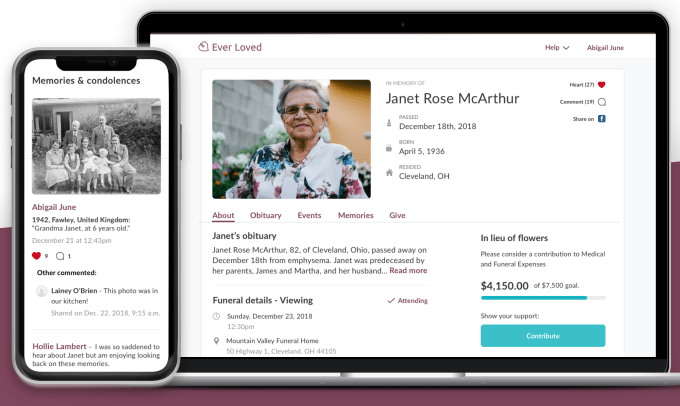
Johnston reveals that 44 percent of families say they had arguments while divvying up assets — a process that takes an average of 560 hours aka 3 months of full-time work. As the baby boomer era ends over the next 30 years, $30 trillion in assets are expected to transfer through estates, she claims. Earning a tiny cut of that by giving mourners tools outlining popular ways to divide estates could alleviate disagreements could make Ever Loved quite lucrative.
“When I first started out, I was pretty awkward about telling people about this. We’re death averse, and that hinders us in a lot of ways” Johnston concludes. My own family struggled with this, as an unwillingness to accept mortality kept my grandparents from planning for after they were gone. “But I quickly learned was this was a huge conversation starter rather than a turn off. This is a topic people want to talk about more and educate themselves more on. Tech too often merely makes life and work easier for those who already have it good. Tech that tempers tragedy is a welcome evolution for Silicon Valley.”
Powered by WPeMatico
With the smartphone operating system market sewn up by Google’s Android platform, which has a close to 90% share globally, leaving Apple’s iOS a slender (but lucrative) premium top-slice, a little company called Jolla and its Linux-based Sailfish OS is a rare sight indeed: A self-styled ‘independent alternative’ that’s still somehow in business.
The Finnish startup’s b2b licensing sales pitch is intended to appeal to corporates and governments that want to be able to control their own destiny where device software is concerned.
And in a world increasingly riven with geopolitical tensions that pitch is starting to look rather prescient.
Political uncertainties around trade, high tech espionage risks and data privacy are translating into “opportunities” for the independent platform player — and helping to put wind in Jolla’s sails long after the plucky Sailfish team quit their day jobs for startup life.
Jolla was founded back in 2011 by a band of Nokia staffers who left the company determined to carry on development of mobile Linux as the European tech giant abandoned its own experiments in favor of pivoting to Microsoft’s Windows Phone platform. (Fatally, as it would turn out.)
Nokia exited mobile entirely in 2013, selling the division to Microsoft. It only returned to the smartphone market in 2017, via a brand-licensing arrangement, offering made-in-China handsets running — you guessed it — Google’s Android OS.
If the lesson of the Jolla founders’ former employer is ‘resistance to Google is futile’ they weren’t about to swallow that. The Finns had other ideas.
Indeed, Jolla’s indie vision for Sailfish OS is to support a whole shoal of differently branded, regionally flavored and independently minded (non-Google-led) ecosystems all swimming around in parallel. Though getting there means not just surviving but thriving — and doing so in spite of the market being so thoroughly dominated by the U.S. tech giant.
TechCrunch spoke to Jolla ahead of this year’s Mobile World Congress tradeshow where co-founder and CEO, Sami Pienimäki, was taking meetings on the sidelines. He told us his hope is for Jolla to have a partner booth of its own next year — touting, in truly modest Finnish fashion, an MWC calendar “maybe fuller than ever” with meetings with “all sorts of entities and governmental representatives”.
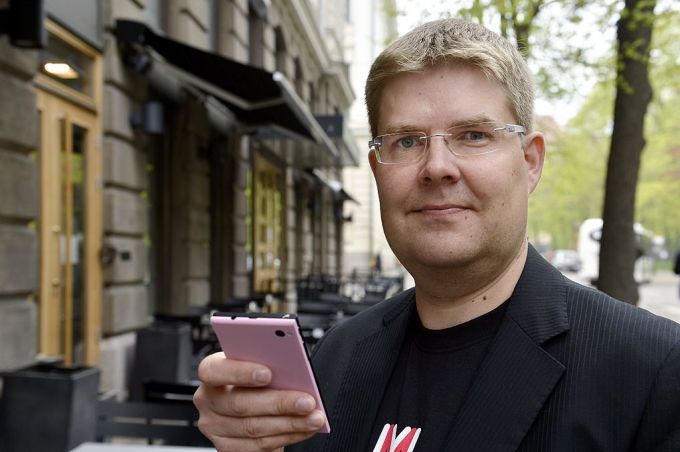
Jolla co-founder, Sami Pienimaki, showing off a Jolla-branded handset in May 2013, back when the company was trying to attack the consumer smartphone space.
(Photo credit: KIMMO MANTYLA/AFP/Getty Images)
Even a modestly upbeat tone signals major progress here because an alternative smartphone platform licensing business is — to put it equally mildly — an incredibly difficult tech business furrow to plough.
Jolla almost died at the end of 2015 when the company hit a funding crisis. But the plucky Finns kept paddling, jettisoning their early pursuit of consumer hardware (Pienimäki describes attempting to openly compete with Google in the consumer smartphone space as essentially “suicidal” at this point) to narrow their focus to a b2b licensing play.
The early b2b salespitch targeted BRIC markets, with Jolla hitting the road to seek buy in for a platform it said could be moulded to corporate or government needs while still retaining the option of Android app compatibility.
Then in late 2016 signs of a breakthrough: Sailfish gained certification in Russia for government and corporate use.
Its licensing partner in the Russian market was soon touting the ability to go “absolutely Google-free!“.
Since then the platform has gained the backing of Russian telco Rostelecom, which acquired Jolla’s local licensing customer last year (as well as becoming a strategic investor in Jolla itself in March 2018 — “to ensure there is a mutual interest to drive the global Sailfish OS agenda”, as Pienimäki puts it).
Rostelecom is using the brand name ‘Aurora OS‘ for Sailfish in the market which Pienimäki says is “exactly our strategy” — likening it to how Google’s Android has been skinned with different user experiences by major OEMs such as Samsung and Huawei.
“What we offer for our customers is a fully independent, regional licence and a tool chain so that they can develop exactly this kind of solution,” he tells TechCrunch. “We have come to a maturity point together with Rostelecom in the Russia market, and it was natural move plan together, that they will take a local identity and proudly carry forward the Sailfish OS ecosystem development in Russia under their local identity.”
“It’s fully compatible with Sailfish operating system, it’s based on Sailfish OS and it’s our joint interest, of course, to make it fly,” he adds. “So that as we, hopefully, are able to extend this and come out to public with other similar set-ups in different countries those of course — eventually, if they come to such a fruition and maturity — will then likely as well have their own identities but still remain compatible with the global Sailfish OS.”
Jolla says the Russian government plans to switch all circa 8M state officials to the platform by the end of 2021 — under a project expected to cost RUB 160.2 billion (~$2.4BN). (A cut of which will go to Jolla in licensing fees.)
It also says Sailfish-powered smartphones will be “recommended to municipal administrations of various levels,” with the Russian state planning to allocate a further RUB 71.3 billion (~$1.1BN) from the federal budget for that. So there’s scope for deepening the state’s Sailfish uptake.
Russian Post is one early customer for Jolla’s locally licensed Sailfish flavor. Having piloted devices last year, Pienimäki says it’s now moving to a full commercial deployment across the whole organization — which has around 300,000 employees (to give a sense of how many Sailfish powered devices could end up in the hands of state postal workers in Russia).
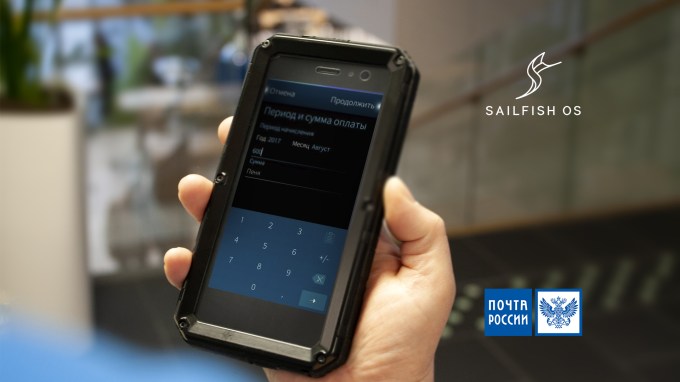
A rugged Sailfish-powered device piloted by Russian post
Jolla is not yet breaking out end users for Sailfish OS per market but Pienimäki says that overall the company is now “clearly above” 100k (and below 500k) devices globally.
That’s still of course a fantastically tiny number if you compare it to the consumer devices market — top ranked Android smartphone maker Samsung sold around 70M handsets in last year’s holiday quarter, for instance — but Jolla is in the b2b OS licensing business, not the handset making business. So it doesn’t need hundreds of millions of Sailfish devices to ship annually to turn a profit.
Scaling a royalty licensing business to hundreds of thousands of users is sums to “good business”, , says Pienimäki, describing Jolla’s business model for Sailfish as “practically a royalty per device”.
“The success we have had in the Russian market has populated us a lot of interesting new opening elsewhere around the world,” he continues. “This experience and all the technology we have built together with Open Mobile Platform [Jolla’s Sailfish licensing partner in Russia which was acquired by Rostelecom] to enable that case — that enables a number of other cases. The deployment plan that Rostelecom has for this is very big. And this is now really happening and we are happy about it.”
Jolla’s “Russia operation” is now beginning “a mass deployment phase”, he adds, predicting it will “quickly ramp up the volume to very sizeable”. So Sailfish is poised to scale.
While Jolla is still yet to turn a full-year profit Pienimäki says several standalone months of 2018 were profitable, and he’s no longer worried whether the business is sustainable — asserting: “We don’t have any more financial obstacles or threats anymore.”
It’s quite the turnaround of fortunes, given Jolla’s near-death experience a few years ago when it almost ran out of money, after failing to close a $10.6M Series C round, and had to let go of half its staff.
It did manage to claw in a little funding at the end of 2015 to keep going, albeit as much leaner fish. But bagging Russia as an early adopter of its ‘independent’ mobile Linux ecosystem looks to have been the key tipping point for Jolla to be able to deliver on the hard-graft ecosystem-building work it’s been doing all along the way. And Pienimäki now expresses easy confidence that profitability will flow “fairly quickly” from here on in.
“It’s not an easy road. It takes time,” he says of the ecosystem-building company Jolla hard-pivoted to at its point of acute financial distress. “The development of this kind of business — it requires patience and negotiation times, and setting up the ecosystem and ecosystem partners. It really requires patience and takes a lot of time. And now we have come to this point where actually there starts to be an ecosystem which will then extend and start to carry its own identity as well.”
In further signs of Jolla’s growing confidence he says it hired more than ten people last year and moved to new and slightly more spacious offices — a reflection of the business expanding.
“It’s looking very good and nice for us,” Pienimäki continues. “Let’s say we are not taking too much pressure, with our investors and board, that what is the day that we are profitable. It’s not so important anymore… It’s clear that that is soon coming — that very day. But at the same time the most important is that the business case behind is proven and it is under aggressive deployment by our customers.”
The main focus for the moment is on supporting deployments to ramp up in Russia, he says, emphasizing: “That’s where we have to focus.” (Literally he says “not screwing up” — and with so much at stake you can see why nailing the Russia case is Jolla’s top priority.)
While the Russian state has been the entity most keen to embrace an alternative (non-U.S.-led) mobile OS — perhaps unsurprisingly — it’s not the only place in the world where Jolla has irons in the fire.
Another licensing partner, Bolivian IT services company Jalasoft, has co-developed a Sailfish-powered smartphone called Accione.

Jalasoft’s ‘liberty’-touting Accione Sailfish smartphone
It slates the handset on its website as being “designed for Latinos by Latinos”. “The digitalization of the economy is inevitable and, if we do not control the foundation of this digitalization, we have no future,” it adds.
Jalasoft founder and CEO Jorge Lopez says the company’s decision to invest effort in kicking the tyres of Jolla’s alternative mobile ecosystem is about gaining control — or seeking “technological libration” as the website blurb puts it.
“With Sailfish OS we have control of the implementation, while with Android it is the opposite,” Lopez tells TechCrunch. “We are working on developing smart buildings and we need a private OS that is not Android or iOS. This is mainly because our product will allow the end user to control the whole building and doing this with Android or iOS a hackable OS will bring concerns on security.”
Lopez says Jalasoft is using Accione as its development platform — “to gather customer feedback and to further develop our solution” — so the project clearly remains in an early phase, and he says that no more devices are likely to be announced this year.
But Jolla can point to more seeds being sewn with the potential, with work, determination and patience, to sprout into another sizeable crop of Sailfish-powered devices down the line.
Even more ambitiously Jolla is also targeting China, where investment has been taken in to form a local consortium to develop a Chinese Sailfish ecosystem.
Although Pienimäki cautions there’s still much work to be done to bring Sailfish to market in China.
“We completed a major pilot with our licensing customer, Sailfish China Consortium, in 2017-18,” he says, giving an update on progress to date. “The public in market solution is not there yet. That is something that we are working together with the customer — hopefully we can see it later this year on the market. But these things take time. And let’s say that we’ve been somewhat surprised at how complex this kind of decision-making can be.”
“It wasn’t easy in Russia — it took three years of tight collaboration together with our Russian partners to find a way. But somehow it feels that it’s going to take even more in China. And I’m not necessarily talking about calendar time — but complexity,” he adds.
While there’s no guarantee of success for Jolla in China, the potential win is so big given the size of the market that even if they can only carve out a tiny slice, such as a business or corporate sector, it’s still worth going after. And he points to the existence of a couple of native mobile Linux operating systems he reckons could make “very lucrative partners”.
That said, the get-to-market challenge for Jolla in China is clearly distinctly different vs the rest of the world. This is because Android has developed into an independent (i.e. rather than Google-led) ecosystem in China as a result of state restrictions on the Internet and Internet companies. So the question is what could Sailfish offer that forked Android doesn’t already?

An Oppo Android powered smartphone on show at MWC 2017
Again, Jolla is taking the long view that ultimately there will be appetite — and perhaps also state-led push — for a technology platform bolster against political uncertainty in U.S.-China relations.
“What has happened now, in particular last year, is — because of the open trade war between the nations — many of the technology vendors, and also I would say the Chinese government, has started to gradually tighten their perspective on the fact that ‘hey simply it cannot be a long term strategy to just keep forking Android’. Because in the end of the day it’s somebody else’s asset. So this is something that truly creates us the opportunity,” he suggests.
“Openly competing with the fact that there are very successful Android forks in China, that’s going to be extremely difficult. But — let’s say — tapping into the fact that there are powers in that nation that wish that there would be something else than forking Android, combined with the fact that there is already something homegrown in China which is not forking Android — I think that’s the recipe that can be successful.”
Not all Jolla’s Sailfish bets have paid off, of course. An earlier foray by an Indian licensing partner into the consumer handset market petered out. Albeit, it does reinforce their decision to zero in on government and corporate licensing.
“We got excellent business connections,” says Pienimäki of India, suggesting also that it’s still a ‘watch this space’ for Jolla. The company has a “second move” in train in the market that he’s hopeful to be talking about publicly later this year.
It’s also pitching Sailfish in Africa. And in markets where target customers might not have their own extensive in-house IT capability to plug into Sailfish co-development work Pienimäki says it’s offering a full solution — “a ready made package”, together with partners, including device management, VPN, secure messaging and secure email — which he argues “can be still very lucrative business cases”.
Looking ahead and beyond mobile, Pienimäki suggests the automotive industry could be an interesting target for Sailfish in the future — though not literally plugging the platform into cars; but rather licensing its technologies where appropriate — arguing car makers are also keen to control the tech that’s going into their cars.
“They really want to make sure that they own the cockpit. It’s their property, it’s their brand and they want to own it — and for a reason,” he suggests, pointing to the clutch of major investments from car companies in startups and technologies in recent years.
“This is definitely an interesting area. We are not directly there ourself — and we are not capable to extend ourself there but we are discussing with partners who are in that very business whether they could utilize our technologies there. That would then be more or less like a technology licensing arrangement.”
While Jolla looks to be approaching a tipping point as a business, in terms of being able to profit off of licensing an alternative mobile platform, it remains a tiny and some might say inconsequential player on the global mobile stage.
Yet its focus on building and maintaining trusted management and technology architectures also looks timely — again, given how geopolitical spats are intervening to disrupt technology business as usual.
Chinese giant Huawei used an MWC keynote speech last month to reject U.S.-led allegations that its 5G networking technology could be repurposed as a spying tool by the Chinese state. And just this week it opened a cybersecurity transparency center in Brussels, to try to bolster trust in its kit and services — urging industry players to work together on agreeing standards and structures that everyone can trust.
In recent years U.S.-led suspicions attached to Russia have also caused major headaches for security veteran Kaspersky — leading the company to announce its own trust and transparency program and decentralize some of its infrastructure, including by spinning up servers in Europe last year.
Businesses finding ways to maintain and deepen the digital economy in spite of a little — or even a lot — of cross-border mistrust may well prove to be the biggest technology challenge of all moving forward.
Especially as next-gen 5G networks get rolled out — and their touted ‘intelligent connectivity’ reaches out to transform many more types of industries, bringing new risks and regulatory complexity.
The geopolitical problem linked to all this boils down to how to trust increasing complex technologies without any one entity being able to own and control all the pieces. And Jolla’s business looks interesting in light of that because it’s selling the promise of neutral independence to all its customers, wherever they hail from — be it Russia, LatAm, China, Africa or elsewhere — which makes its ability to secure customer trust not just important but vital to its success.
Indeed, you could argue its customers are likely to rank above average on the ‘paranoid’ scale, given their dedicated search for an alternative (non-U.S.-led) mobile OS in the first place.
“It’s one of the number one questions we get,” admits Pienimäki, discussing Jolla’s trust balancing act — aka how it manages and maintains confidence in Sailfish’s independence, even as it takes business backing and code contributions from a state like Russia.
“We tell about our reference case in Russia and people quickly ask ‘hey okay, how can I trust that there is no blackbox inside’,” he continues, adding: “This is exactly the core question and this is exactly the problem we have been able to build a solution for.”
Jolla’s solution sums to one line: “We create a transparent platform and on top of fully transparent platform you can create secure solutions,” as Pienimäki puts it.
“The way it goes is that Jolla with Sailfish OS is always offering the transparent Sailfish operating system core, on source code level, all the time live, available for all the customers. So all the customers constantly, in real-time, have access to our source code. Most of it’s in public open source, and the proprietary parts are also constantly available from our internal infrastructure. For all the customers, at the same time in real-time,” he says, fleshing out how it keeps customers on board with a continually co-developing software platform.
“The contributions we take from these customers are always on source code level only. We don’t take any binary blobs inside our software. We take only source code level contributions which we ourselves authorize, integrate and then we make available for all the customers at the very same moment. So that loopback in a way creates us the transparency.
“So if you want to be suspicion of the contributions of the other guys, so to say, you can always read it on the source code. It’s real-time. Always available for all the customers at the same time. That’s the model we have created.”
“It’s honestly quite a unique model,” he adds. “Nobody is really offering such a co-development model in the operating system business.
“Practically how Android works is that Google, who’s leading the Android development, makes the next release of Android software, then releases it under Android Open Source and then people start to backboard it — so that’s like ‘source, open’ in a way, not ‘open source’.”
Sailfish’s community of users also have real-time access to and visibility of all the contributions — which he dubs “real democracy”.
“People can actually follow it from the code-line all the time,” he argues. “This is really the core of our existence and how we can offer it to Russia and other countries without creating like suspicion elements each side. And that is very important.
“That is the only way we can continue and extend this regional licensing and we can offer it independently from Finland and from our own company.”
With global trade and technology both looking increasingly vulnerable to cross-border mistrust, Jolla’s approach to collaborative transparency may offer something of a model if other businesses and industries find they need to adapt themselves in order for trade and innovation to keep moving forward in uncertain political times.
Last but not least there’s regulatory intervention to consider.
A European Commission antitrust decision against Google’s Android platform last year caused headlines around the world when the company was slapped with a $5BN fine.
More importantly for Android rivals Google was also ordered to change its practices — leading to amended licensing terms for the platform in Europe last fall. And Pienimäki says Jolla was a “key contributor” to the Commission case against Android.

European competition commissioner Margrethe Vestager, on April 15, 2015 in Brussels, as the Commission said it would open an antitrust investigation into Google’s Android operating system. (Photo credit: JOHN THYS/AFP/Getty Images)
The new Android licensing terms make it (at least theoretically) possible for new types of less-heavily-Google-flavored Android devices to be developed for Europe. Though there have been complaints the licensing tweaks don’t go far enough to reset Google’s competitive Android advantage.
Asked whether Jolla has seen any positive impacts on its business following the Commission’s antitrust decision, Pienimäki responds positively, recounting how — “one or two weeks after the ruling” — Jolla received an inbound enquiry from a company in France that had felt hamstrung by Google requiring its services to be bundled with Android but was now hoping “to realize a project in a special sector”.
The company, which he isn’t disclosing at this stage, is interested in “using Sailfish and then having selected Android applications running in Sailfish but no connection with the Google services”.
“We’ve been there for five years helping the European Union authorities [to build the case] and explain how difficult it is to create competitive solutions in the smartphone market in general,” he continues. “Be it consumer or be it anything else. That’s definitely important for us and I don’t see this at all limited to the consumer sector. The very same thing has been a problem for corporate clients, for companies who provide specialized mobile device solutions for different kind of corporations and even governments.”
While he couches the Android ruling as a “very important” moment for Jolla’s business last year, he also says he hopes the Commission will intervene further to level the smartphone playing field.
“What I’m after here, and what I would really love to see, is that within the European Union we utilize Linux-based, open platform solution which is made in Europe,” he says. “That’s why we’ve been pushing this [antitrust action]. This is part of that. But in bigger scheme this is very good.”
He is also very happy with Europe’s General Data Protection Regulation (GDPR) — which came into force last May, plugging in a long overdue update to the bloc’s privacy rules with a much beefed up enforcement regime.
GDPR has been good for Jolla’s business, according to Pienimäki, who says interest is flowing its way from customers who now perceive a risk to using Android if customer data flows outside Europe and they cannot guarantee adequate privacy protections are in place.
“Already last spring… we have had plenty of different customer discussions with European companies who are really afraid that ‘hey I cannot offer this solution to my government or to my corporate customer in my country because I cannot guarantee if I use Android that this data doesn’t go outside the European Union’,” he says.
“You can’t indemnify in a way that. And that’s been really good for us as well.”
Powered by WPeMatico
I co-run an agency that teaches a hundred startups per year how to do growth marketing. This gives me a unique vantage point: I know which types of startups most often reach profitability.
That’s an important metric, because startups that don’t reach this milestone typically fail to raise additional funding — then die.
Here’s what we’ll learn:
Our sampling of startups isn’t as biased as startup valuation leaderboards, because we also see those that failed. That’s the key.
You can use our experience to de-risk your startup. That’s what this post explores: How to change your product roadmap to pursue a path more likely to reach profitability.
Here’s the data my agency is referencing for this post:
When we try to control for founder skill and funds raised, the types of startups that first reach profitability do so in this order:
On average, an e-commerce company is more likely to first reach profitability than an SMB SaaS company.
Before I explain why, let me explain how we’re differentiating startups: I use the word “type” instead of “business model” or “markets” because I’ve learned that business model and market are often not the best predictors of success. Instead, it’s your approach to customer acquisition. That’s what typically determines the likelihood of profitability.
Powered by WPeMatico
Sam Altman, the well-known president of the prolific Silicon Valley accelerator Y Combinator, is stepping down, the firm shared in a blog post on Friday.
Altman is transitioning into a chairman role with other YC partners stepping up to take on his day-to-day responsibilities, as first reported by Axios. Sources tell TechCrunch YC has no succession plans. YC’s core program is currently led by chief executive officer Michael Seibel, who joined the firm as a part-time partner in 2013 and assumed the top role in 2016.
The news comes amid a series of shake-ups at the accelerator, which is expected to demo its latest batch of 200-plus companies in San Francisco March 18 and 19. In Friday’s blog post, YC expands on some of those changes, including the firm’s decision to move it’s HQ to San Francisco, which TechCrunch reported earlier this week.
“We are considering moving YC to the city and are currently looking for space,” YC writes. “The center of gravity for new startups has clearly shifted over the past five years, and although we love our space in Mountain View, we are rethinking whether the logistical tradeoff is worth it, especially given how difficult the commute has become. We also want to be closer to our Bay Area alumni, who disproportionately live and work in San Francisco.”
In addition to moving it’s HQ up north, YC has greatly expanded the size of its cohorts — so much so that it’s next demo day will have two stages — and it’s writing larger checks to portfolio companies.
Altman, who joined YC as a partner in 2011 and was named president in 2014, will focus on other efforts, including OpenAI, a research organization in which he co-chairs. Altman was the second-ever YC president, succeeding YC co-founder Paul Graham in 2014. Graham is currently an advisor to YC.
Powered by WPeMatico
What if, instead of sitting on your phone on the sofa ordering stuff from Amazon, you could buy the same things locally from local stores that ultimately enliven and enrich your local neighborhood? What if by doing that, you wouldn’t be walking through deserted main streets, past boarded-up shops, dark alleys and graffiti? What if someone created a marketplace for independent businesses, local events and experiences that kept the money in the local economy rather than being siphoned off into global giants who don’t care about human-scale communities?
That’s the idea behind Pixie, a new take on the “shop-local app” startup model which, although it’s been tried before, has never quite managed to take off. Perhaps Pixie will have more luck?
Here’s how it works: The Pixie app connects people to independent businesses through a curated marketplace, incentivizing them to pay through the app and get rewarded for being loyal customers. Integrated into the app is Pixie Pay, a bespoke payment solution which keeps money in local hands.
The startup has a fascinating background. Whilst serving in the British Special Forces, Pixie’s founder Greg Barden understood that his mission was also to ‘win hearts and minds’ with the local population. Whether by buying bread from the local baker in a village in Afghanistan, or coffee from the market in Baghdad, he and his soldiers could tear down even the most hostile barriers.
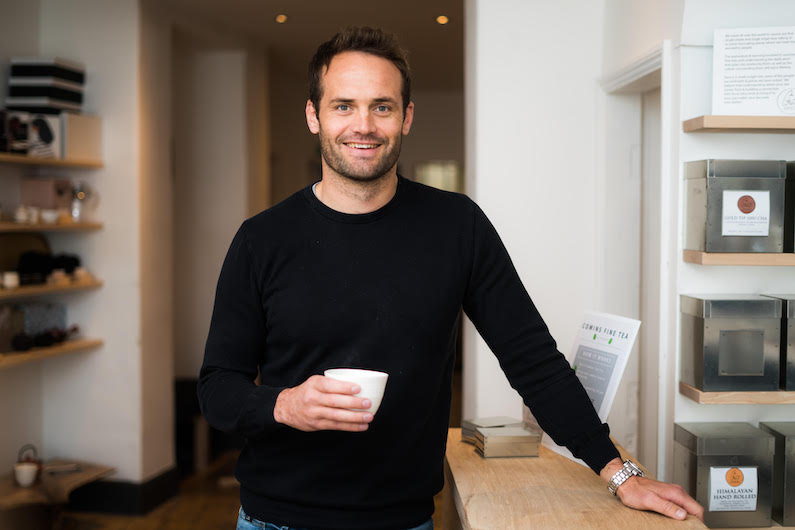
He also realized that when more money stayed inside these the local economies rather than being sucked away by organized crime or large scale, globalized businesses, the local economy might flourish and the risk of the societies there becoming yet again destabilized could potentially diminish.
“Whether it was stalls in the bazaars of Baghdad or small boutiques on Bath high-street, I realized independent shop owners are linchpins in their community. They add variety to the mundane and nurture community spirit. Even local guardians need protecting sometimes, which is why we created Pixie.”
The threat to independent stores from globalization and digitization isn’t just happening in Afghanistan. Across the western world, ‘Main Street’ stores are closing at a prodigious rate. In the UK over 1,500 local stores closed in 2018. (And that was BEFORE Brexit…)
Pixie has stress-tested its idea in mid-sized town in the UK, including Bath, Frome and Sherbourne, completing transactions across 250 businesses, ranging from cafes to fashion boutiques, and spinning up 5,000 app users. It’s now going on the fund-raising trail, aiming to raise £500,000 in funding through its ‘Equity for Explorers’ campaign on Crowdcube a UK-based crowd-equity platform. The total addressable market for independent business in the UK is estimated to be £31.5bn in gross transactional value.
Barden — who last year spoke about his startup life at the launch of the military tech non-profit TechVets — says: “There might be thousands of independent businesses across the UK, but at the rate the high-street is disappearing they are severely under threat. Pixie isn’t here to turn people away from the bigger players on the high-street, but create opportunities for enriching discovery. Needless to say, in a world with increasing nationalism, Brexit, Trump and — dare I say it — Amazon, we feel Pixie has a huge part to play in countering the worst aspects of globalization.”
Pixie’s revenue comes from transaction fees taken when people use its ‘Pixie Pay’ payment mechanism. The payment system is designed to bypass Visa/Mastercard at the point of sale, whilst the loyalty scheme unites independent businesses under one umbrella, so the users can earn and spend their loyalty points (as money) across the entire Pixie community. If a store using Pixie is in Australia, a person from Bath could also use their points there. This keeps the money circulating inside local, independent stores, wherever they are on the planet.
Pixie distributes its own payment terminal that sits next to whatever the business has in place to take normal card payments (iZettle etc). The cards are contactless but don’t utilise visa MasterCard. It’s literally their own e-money system. Think PayPal where users can either add money to their balance by debit card or bank and/or link a debit card to Pixie if they don’t have a balance.
Obviously this also creates it an alternative to competitors like iZettle, Square, SumUp and WorldPay, but this time specifically aimed at local independent stores, not huge national and international chains.
The third element of Pixie is its discovery marketplace that gives its community of explorers (users) the ability to discover local businesses across the Pixie footprint of stores.
I’ve seen several startups try and tackle this problem, but it may well be that Pixie, under its charismatic leader, finally has a shot at cracking this idea around local markets.
Powered by WPeMatico
Ten years after the launch of Foursquare at SXSW, the company is laying its technology bare with a futuristic version of its old app that doesn’t require a check-in at all. The godfather of location apps is returning to the launchpad with Hypertrending, but this time it hopes to learn what developers might do with real-time info about where people are and where they aren’t.
Hypertrending uses Foursquare’s Pilgrim technology, which is baked into Foursquare’s apps and offered as a third-party enterprise tool, to show where phones are in real time over the course of SXSW in Austin, Texas.
This information is relayed through dots on a map. The size of those dots is a reflection of the number of devices in that place at a given time. Users can filter the map by All places, Food, Nightlife and Fun (events and parties).
Hypertrending also has a Top 100 list that is updated in real time to show which places are super popular, with arrows to show whether a place is trending up or down.
Before you throw up your hands in outrage, the information on Hypertrending is aggregated and anonymized (just like it is within Pilgrim), and there are no trails showing the phone’s route from one place to another. Dots only appear on the map when the phone arrives at a destination.
Hypertrending was cooked up in Foursquare’s skunkworks division, Foursquare Labs, led by the company’s co-founder Dennis Crowley .
The feature is only available during SXSW and in the Austin area, and thus far Foursquare has no plans to launch this publicly. So… what’s the deal?
First and foremost, Hypertrending is about showing off the technology. In many ways, Hypertrending isn’t new at all, in that it runs off the Pilgrim technology that has powered Foursquare since around 2014.
Pilgrim is the tech that recognizes you’ve just sat down at a restaurant and offers up a tip about the menu on Foursquare City Guide, and it’s the same tech that notices you’ve just touched down in a new city and makes some recommendations on places to go. In Swarm, it’s the tech that offers up a list of all the places you’ve been in case you want to retroactively check in to them.
That sounds rather simple, but a combination of Foursquare’s 10 years’ worth of location data and Pilgrim’s hyper-precision is unparalleled when it comes to accuracy, according to Crowley.
Whereas other location tech might not understand the difference between you being in the cafe on the first floor or the salon on the second floor, or the bar that shares a wall with both, Pilgrim does.
This is what led Foursquare to build out the Pilgrim SDK, which now sees more than 100 million user-confirmed visits per month. Apps that use the Pilgrim SDK offer users the ability to opt-in to Foursquare’s always-on location tracking for its mobile app panel in the U.S., which has grown to 10 million devices.
These 10 million phones provide the data that powers Hypertrending.
Now, the data itself might not be new, per se. But Foursquare has never visualized the information quite like this, even for enterprise customers.
Whereas customers of the Foursquare Place Insights, Pinpoint and Attribution get snapshots into their own respective audiences, Hypertrending represents on a large scale just what Foursquare’s tech is capable of in not only knowing where people are, but where people aren’t.

This brings us back to SXSW, which happens to be the place where Foursquare first launched back in 2009.
“This week has felt a little nostalgic as we try to get this thing ready to go,” said Crowley. “It’s not that dissimilar to when we went to SXSW in 2009 and showed off Foursquare 1.0. There is this curious uncertainty and my whole thing is to get a sense of what people think of it.”
Crowley recalled his first trip to SXSW with co-founder Naveen Selvadurai. They couldn’t afford an actual pass to the show so they just went from party to party showing people the app and hearing what they thought. Crowley said that he doesn’t expect Hypertrending to be some huge consumer app.
“I want to show off what we can do with the technology and the data and hopefully inspire developers to do interesting stuff with this raw visualization of where phones are at,” said Crowley. “What would you do if you had access to this? Would you make something cool and fun or make something obnoxious and creepy?”
Beyond the common tie of SXSW, Hypertrending brings Foursquare’s story full circle in the fact that it’s potentially the most poignant example of what Crowley always wanted Foursquare to be. Location is one of the most powerful pieces of information about an individual. One’s physical location is, in many ways, the most purely truthful piece of information about them in a sea of digital clicks and scroll-bys.
If this data could be harnessed properly, without any work on the side of the consumer, what possibilities might open up?
“We’ve long talked about making ‘a check-in button you never had to press,’ ” said Crowley in the blog post. “Hypertrending is part of that vision realized, spread across multiple apps and services.”
Crowley also admits in the blog post that Hypertrending walks a fine line between creepy and cool, which is another reason for the ephemeral nature of the feature. It’s also the exact reason he wants to open it up to everyone.
From the blog post:
After 10 years, it’s clear that we (Foursquare!) are going to play a role in influencing how contextual-aware technologies shape the future – whether that’s apps that react to where you are and where you’ve been, smarter virtual assistants (e.g Alexa, Siri, Marsbot) that understand how you move through cities, or AR objects that need to appear at just the right time in just the right spot. We want to build a version of the future that we’re proud of, and we want your input as we get to work building it.
And…
We made Hypertrending to show people how Foursquare’s panel works in terms of what it can do (and what it will not do), as well as to show people how we as a company think about navigating this space. We feel the general trend with internet and technology companies these days has been to keep giving users a more and more personalized (albeit opaquely personalized) view of the world, while the companies that create these feeds keep the broad “God View” to themselves. Hypertrending is one example of how we can take Foursquare’s aggregate view of the world and make it available to the users who make it what it is. This is what we mean when we talk about “transparency” – we want to be honest, in public, about what our technology can do, how it works, and the specific design decisions we made in creating it.
We asked Crowley what would happen if brands and marketers loved the idea of Hypertrending, but general consumers were freaked out?
“This is an easy question,” said Crowley. “If this freaks people out, we don’t build stuff with it. We’re not ready for it yet. But I’d go back to the drawing board and ask ‘What do we learn from people that are freaked out about it that would help us communicate to them,’ or ‘what are the changes we could make to this that would make people comfortable,’ or ‘what are the things we could build that would illustrate the value of this that this view didn’t communicate?’ ”
As mentioned above, Hypertrending is only available during the SXSW conference in the Austin area. Users can access Hypertrending through both the Foursquare City Guide app and Swarm by simply shaking their phone.
Powered by WPeMatico
Serial Box, a startup bringing back the tradition of serialized fiction, has raised $4.5 million in seed funding.
The company actually disclosed the funding last week when announcing a partnership to produce stories about Marvel characters, but it’s sharing more details about the round — namely, the fact that it was led by Boat Rocker Media, with participation from Forerunner Ventures, 2929 Entertainment co-founder Todd Wagner and Japanese business intelligence and media firm Uzabase.
“We carefully chose trusted partners for this round of investment,” said co-founder and CEO Molly Barton in a statement. “They see the big opportunity that we do to retool reading for the smartphone age, to take the best elements of traditional book publishing and innovate with influences from the audio, podcast, gaming and TV industries.”
Serial Box publishes stories in text and audio format, broken up into weekly episodes. The first episode of each story is free — then if you’re hooked, you can pay $1.99 for additional episodes or sign up for a season pass.
The idea of making readers and listeners wait for the next chapter of the story may seem strange. Hasn’t Netflix trained us to want to binge the full season, as soon as possible? Maybe, but anyone who has watched “Game of Thrones” week-to-week knows that there’s still immense pleasure in waiting for smaller chunks of the larger story.
Behind the scenes, the company is borrowing from the TV production model, with a showrunner leading each writing time creating the stories. Serial Box writers include popular YA/science fiction/fantasy authors Gwenda Bond, Yoon Ha Lee, Max Gladstone and Becky Chambers. And, as mentioned, the company will also be publishing stories based on Marvel characters, starting with Thor.
The company says it will launch its Android app next week, with plans for more product upgrades and content partnerships in the coming months.
Powered by WPeMatico
During its earnings report yesterday afternoon, Okta announced it intends to acquire Azuqua, a Seattle, Wash. workflow automation startup, for $52.5 million.
In a blog post announcing the news, Okta co-founder and COO Frederic Kerrest saw the combining of the two companies as a way to move smoothly between applications in a complex workflow without having to constantly present your credentials.
“With Okta and Azuqua, IT teams will be able to use pre-built connectors and logic to create streamlined identity processes and increase operational speed. And, product teams will be able to embed this technology in their own applications alongside Okta’s core authentication and user management technology to build…integrated customer experiences,” Kerrest wrote.
In a modern enterprise, people and work are constantly shifting and moving between applications and services and combining automation software with identity and access management could offer a seamless way to move between them.
This represents Okta’s largest acquisition to-date and follows Stormpath almost exactly two years ago and ScaleFT last July. Taken together, you can see a company that is trying to become a more comprehensive identity platform.
Azuqua, which has raised $16 million since it launched in 2013, appears to have given investors a pretty decent return. When the deal closes, Okta intends to move the Azuqua team to its Bellevue offices, increasing its presence in the Northwest. Okta’s headquarters are in San Francisco. Azuqua customers include Airbnb, McDonald’s, VMware and HubSpot,
Okta was founded in 2009 and raised over $229 million before going public April, 2017.
Powered by WPeMatico
David Mayman has a vision for personal aviation that he’s spent the past dozen years and millions of his personal fortune chasing. He hasn’t accepted the convention that jetpacks were just a misguided fantasy for the future; his company, Jetpack Aviation, has been building them and he’s been zooming around in publicity-grabbing stunts in a plea to the public that there’s room to dream when it comes to human flight.
And while an eight-person startup aiming to build out a fleet of $380,000 “flying motorcycles” might seem like a tall order, Y Combinator, a top accelerator known for its occasionally bizarre bets, is gambling on the company and its jet engine-obsessed CEO in one of its latest investments.
Jetpack Aviation is about to become a very different company. The startup has launched pre-orders this week for the moonshot of moonshots, the Speeder, a personal vertical take-off and landing vehicle with a svelte concept design that looks straight out of Star Wars or Halo.
Deep-pocketed, sci-fi-minded buyers are going to have to fork over $10,000 just to get a spot in the pre-order line for the first vehicles to ship, but the startup’s founder seems to see the campaign as less about the money than it is about the confirmation that there are people interested in planting a stake in his wild company’s future success.
“I think it’s a validation statement for all of us,” Mayman tells TechCrunch. “If you look at how long Tesla took to deliver the Model 3 to customers, I think people understand that this is not something that’s a Kickstarted pre-delivery campaign where at the tail-end of it we’re immediately going to be delivering product.”
There are gambles and then there are flying motorcycles. This is frankly an atypical startup for YC to fund, but it is also an unconventional business path for Mayman, who has largely been self-financing his jetpack-building obsession for the past 12 years. For the Australian CEO, the YC investment is mainly about gaining access to Silicon Valley’s network of VCs, though he also acknowledges it’s a fair assumption that SF breeds the type of executive that might be interested in pre-ordering something so seemingly outlandish.
While much of the excitement Mayman has raised for his company’s jetpacks has relied on the spectacle of prototype demos in front of throngs of news networks (Jetpack Aviation has unsurprisingly partnered with Red Bull), the company has yet to build a full-scale prototype of the Speeder, though he says their new round of funding should get them there.

Mayman flying a jetpack around the Statue of Liberty in 2015
Can they actually build this? That’s seems to be a pretty valid question.
In our conversation, Mayman acknowledges upfront that:
Jetpack Aviation’s current design is more ambitious than most helicopter-shaped concept VTOL vehicles being pursued by companies like Uber, namely due to its relatively sleek design where the human rider is directly above a set of several gimbal-mounted jet engines.
The company claims finished designs will move faster than 150 mph at altitudes up to 15,000 feet. The flight time is still a limiting factor; max flight times for the models are estimated to be around 30 minutes. The company is planning a number of versions, including an ultralight model that complies with some federal regulations and won’t require a pilot’s license, the company says.
The startup’s most pertinent problem is creating the autonomous stabilization technologies that will make flying the Speeder effortless and safe. Mayman notes that most VTOL designs look like quadcopters simply because the physics of putting weight directly on top of the thrust system is so challenging. “It’s like trying to balance a pencil on your finger,” he says.
His team has been training people to use their jetpacks — now in their 11th design iteration — and say it takes about a week to get potential flyers up-and-running with the particulars of the system. But Mayman says he wants this to be a device that just works, a design concept that made a lot of sense when Steve Jobs was using it to refer to the simplicity of the iPad, but feels a tad more aggressive when presented with the rendered images of someone flying this thing over city centers:
A lot of the industry’s existing work around autonomous flight and stabilization for drone aircraft really doesn’t account for Jetpack Aviation’s design, though Mayman says they’ve already made some significant progress with their 1:3 scale prototype. He also notes that the company does have a “less elegant-looking” plan-B design if they determine the centrally clustered jet engines are too much of a stabilization liability.
Indeed, the key for getting a concept like this off the ground and ensuring the company doesn’t miserably fail is being flexible about how this vision matures, Mayman says, noting that they’re approaching the vehicle with multiple designs and multiple considerations for how the regulatory environment for certification shapes up, including work on a separate military version and consideration for designs more focused on emergency response like rapid medical evacuation.
Asked whether pre-orderers plunking down $10K might be disappointed by a different-looking product, the founder said that they’ve done enough modeling to know that what they build will fall into a roughly similar design. “It may not look exactly like what we’ve rendered, but I’m confident that it’s still going to be the same sort of concept, a motorcycle or jet-ski size and shape.”
It is certainly a unique choice for the company to launch its pre-orders already with so much in the air, but it’s fairly apparent that they are looking to emulate Tesla here, and if people with nearly $400K to throw around want to buy a jet-engine jet-ski, then by all means, let the free market do its thing.
Y Combinator’s $150,000 investment is an early step for the moonshot effort and a vote of confidence that places them on others’ radar. Mayman, for his part, does seem genuinely thrilled about expanding the ambitions of his passion project, even if the road ahead is crowded with obstacles for realizing the vision.
“If you don’t start it, you’re never going to get there,” Mayman says. “If our guys weren’t able to wake up every morning saying, ‘Holy shit, this would be freaking amazing if we can build this,’ then it’s sort of not worth doing. We might as well go do something else.”
Powered by WPeMatico
Many things are better said than read, but the best voice tech out there seems to be reserved for virtual assistants, not screen readers or automatically generated audiobooks. WellSaid wants to enable any creator to use quality synthetic speech instead of a human voice — perhaps even a synthetic version of themselves.
There’s been a series of major advances in voice synthesis over the last couple of years as neural network technology improves on the old highly manual approach. But Google, Apple and Amazon seem unwilling to make their great voice tech available for anything but chirps from your phone or home hub.
As soon as I heard about WaveNet, and later Tacotron, I tried to contact the team at Google to ask when they’d get to work producing natural-sounding audiobooks for everything on Google Books, or as a part of AMP, or make it an accessibility service, and so on. Never heard back. I considered this a lost opportunity, as there are many out there who need such a service.
So I was pleased to hear that WellSaid is taking on this market, after a fashion, anyway. The company is the first to launch from the Allen Institute for AI (AI2) incubator program announced back in 2017. They do take their time!
I talked with the co-founders CEO Matt Hocking and CTO Michael Petrochuk, who explained why they went about creating a whole new system for voice synthesis. The basic problem, they said, is that existing systems not only rely on a lot of human annotation to sound right, but they “sound right” the exact same way every time. You can’t just feed it a few hours of audio and hope it figures out how to inflect questions or pause between list items — much of this stuff has to be spelled out for them. The end result, however, is highly efficient.
 “Their goal is to make a small model for cheap [i.e. computationally] that pronounces things the same way every time. It’s this one perfect voice,” said Petrochuk. “We took research like Tacotron and pushed it even further — but we’re not trying to control speech and enforce this arbitrary structure on it.”
“Their goal is to make a small model for cheap [i.e. computationally] that pronounces things the same way every time. It’s this one perfect voice,” said Petrochuk. “We took research like Tacotron and pushed it even further — but we’re not trying to control speech and enforce this arbitrary structure on it.”
“When you think about the human voice, what makes it natural, kind of, is the inconsistencies,” said Hocking.
And where better to find inconsistencies than in humans? The team worked with a handful of voice actors to record dozens of hours of audio to feed to the system. There’s no need to annotate the text with “speech markup language” to designate parts of sentences and so on, Petrochuk said: “We discovered how to train off of raw audiobook data, without having to do anything on top of that.”
So WellSaid’s model will often pronounce the same word differently, not because a carefully manicured manual model of language suggested it do so, but because the person whose vocal fingerprint it is imitating did so.
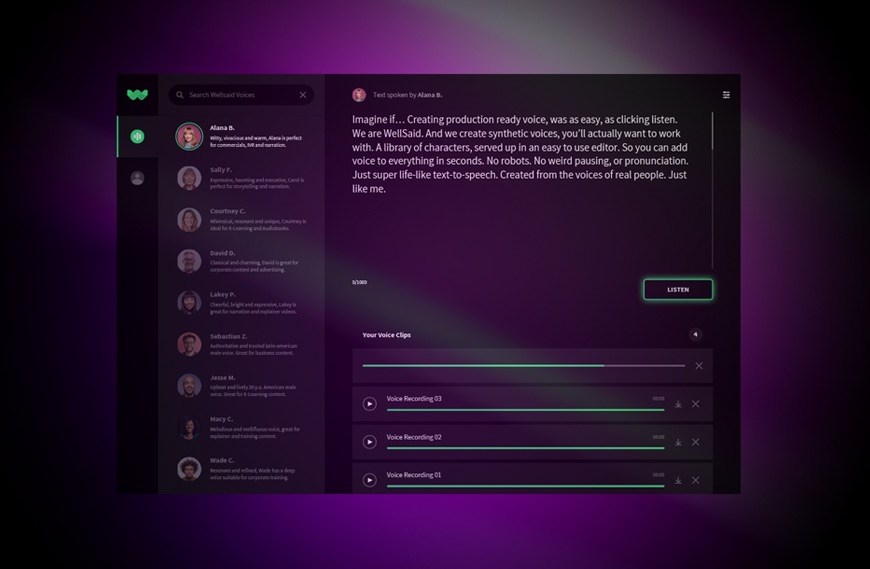 And how does that work, exactly? That question seems to dip into WellSaid’s secret sauce. Their model, like any deep learning system, is taking innumerable inputs into account and producing an output, but it is larger and more far-reaching than other voice synthesis systems. Things like cadence and pronunciation aren’t specified by its overseers but extracted from the audio and modeled in real time. Sounds a bit like magic, but that’s often the case when it comes to bleeding-edge AI research.
And how does that work, exactly? That question seems to dip into WellSaid’s secret sauce. Their model, like any deep learning system, is taking innumerable inputs into account and producing an output, but it is larger and more far-reaching than other voice synthesis systems. Things like cadence and pronunciation aren’t specified by its overseers but extracted from the audio and modeled in real time. Sounds a bit like magic, but that’s often the case when it comes to bleeding-edge AI research.
It runs on a CPU in real time, not on a GPU cluster somewhere, so it can be done offline as well. This is a feat in itself, as many voice synthesis algorithms are quite resource-heavy.
What matters is that the voice produced can speak any text in a very natural-sounding way. Here’s the first bit of an article — alas, not one of mine, which would have employed more mellifluous circumlocutions — read by Google’s WaveNet, then by two of WellSaid’s voices.
The latter two are definitely more natural sounding than the first. On some phrases the voices may be nearly indistinguishable from their originals, but in most cases I feel sure I could pick out the synthetic voice in a few words.
That it’s even close, however, is an accomplishment. And I can certainly say that if I was going to have an article read to my by one of these voices, it would be WellSaid’s. Naturally it can also be tweaked and iterated, or effects applied to further manipulate the sound, as with any voice performance. You didn’t think those interviews you hear on NPR are unedited, did you?
The goal at first is to find the creatives whose work would be improved or eased by adding this tool to their toolbox.
“There are a lot of people who have this need,” explained Hocking. “A video producer who doesn’t have the budget to hire a voice actor; someone with a large volume of content that has to be iterated on rapidly; if English is a second language, this opens up a lot of doors; and some people just don’t have a voice for radio.”
It would be nice to be able to add voice with a click rather than just have block text and royalty-free music over a social ad (think the admen):
I asked about the reception among voice actors, who of course are essentially being asked to train their own replacements. They said that the actors were actually positive about it, thinking of it as something like stock photography for voice; get a premade product for cheap, and if you like it, pay the creator for the real thing. Although they didn’t want to prematurely lock themselves into future business models, they did acknowledge that revenue share with voice actors was a possibility. Payment for virtual representations is something of a new and evolving field.
A closed beta launches today, which you can sign up for at the company’s site. They’re going to be launching with five voices to start, with more voices and options to come as WellSaid’s place in the market becomes clear. Part of that process will almost certainly be inclusion in tools used by the blind or otherwise disabled, as I have been hoping for years.
And what comes after that? Making synthetic versions of users’ voices, of course. No brainer! But the two founders cautioned that’s a ways off for several reasons, even though it’s very much a possibility.
“Right now we’re using about 20 hours of data per person, but we see a future where we can get it down to one or two hours while maintaining a premium lifelike quality to the voice,” said Petrochuk.
“And we can build off existing data sets, like where someone has a back catalog of content,” added Hocking.
The trouble is that the content may not be exactly right for training the deep learning model, which advanced as it is can no doubt be finicky. There are dials and knobs to tweak, of course, but they said that fine-tuning a voice is more a matter of adding corrective speech, perhaps having the voice actor reading a specific script that props up the sounds or cadences that need a boost.
They compared it with directing such an actor rather than adjusting code. You don’t, after all, tell an actor to increase the pauses after commas by 8 percent or 15 milliseconds, whichever is longer. It’s more efficient to demonstrate for them: “say it like this.”
Even so, getting the quality just right with limited and imperfect training data is a challenge that will take some serious work if and when the team decides to take it on.
But as some of you may have noticed, there are also some parallels to the unsavory world of “deepfakes.” Download a dozen podcasts or speeches and you’ve got enough material to make a passable replica of someone’s voice, perhaps a public figure. This of course has a worrying synergy with the existing ability to fake video and other imagery.
This is not news to Hocking and Petrochuk. If you work in AI, this kind of thing is sort of inevitable.
“This is a super important question and we’ve considered it a lot,” said Petrochuk. “We come from AI2, where the motto is ‘AI for the common good.’ That’s something we really subscribe to, and that differentiates us from our competitors who made Barack Obama voices before they even had an MVP [minimum viable product]. We’re going to watch closely to make sure this isn’t being used negatively, and we’re not launching with the ability to make a custom voice, because that would let anyone create a voice from anyone.”
Active monitoring is just about all anyone with a potentially troubling AI technology can be expected to do — though they are looking at mitigation techniques that could help identify synthetic voices.
With the ongoing emphasis on multimedia presentation of content and advertising rather than written, WellSaid seems poised to make an early play in a growing market. As the product evolves and improves, it’s easy to picture it moving into new, more constrained spaces, like time-shifting apps (instant podcast with five voices to choose from!) and even taking over territory currently claimed by voice assistants. Sounds good to me.
Powered by WPeMatico